
Dragon Quest II: Luminaries of the Legendary Line, titled Dragon Warrior II when initially localized to North America, is a role-playing video game developed by Chunsoft and published by Enix in 1987 for the Nintendo Entertainment System as a part of the Dragon Quest series. Enix's U.S. subsidiary published the American release, Dragon Warrior II, for the Nintendo Entertainment System in 1990. Dragon Quest II is set one hundred years after the events of the first game.
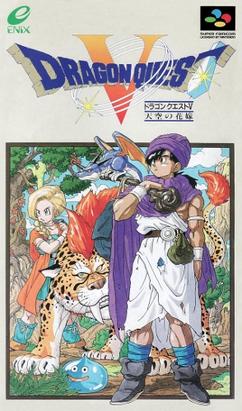
Dragon Quest V: Hand of the Heavenly Bride is a role-playing video game and the fifth installment in the Dragon Quest video game series, second of the Zenithian Trilogy. Originally developed by Chunsoft and published by Enix Corporation, Dragon Quest V was the first title in the series to be released for the Super Famicom video game console in Japan in September 1992. Dragon Quest V was the first game in the series to not be released in America due to programming issues at the time.
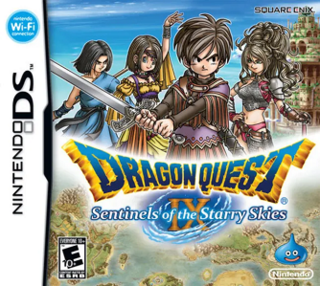
Dragon Quest IX: Sentinels of the Starry Skies is a role-playing video game co-developed by Level-5 and Square Enix for the Nintendo DS. Published by Square Enix in Japan in 2009, and by Nintendo overseas in 2010, it is the ninth mainline entry in the Dragon Quest series. The storyline follows the protagonist, a member of the angelic Celestrian race, after a disaster in their home scatters magical fruits across the mortal realm. While carrying over traditional gameplay from the rest of the series with turn-based battles, the game is the first Dragon Quest entry to feature a customizable player character, and the first to include a multiplayer mode, with the option of trading treasure maps and loaning player characters through Nintendo Wi-Fi. Online functions ended in 2014 when it ceased operations.
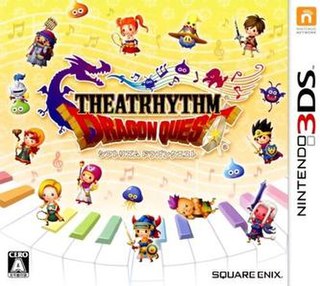
Theatrhythm Dragon Quest is a 2015 rhythm game developed by indieszero and published by Square Enix for the Nintendo 3DS in Japan. It was the first game of its type in the Dragon Quest series, and the third Theatrhythm game after Theatrhythm Final Fantasy and Theatrhythm Final Fantasy: Curtain Call. While following rhythm games' formula, players hit notes on the beat of music. The title also incorporates role-playing elements, allowing players to assemble a party of four characters to engage in battles or march automatically, in synchronizing with the players' beats.

Dragon Quest Builders is a 2016 sandbox action role-playing game developed and published by Square Enix for the PlayStation 3, PlayStation 4, PlayStation Vita, Android iOS, and Microsoft Windows and published by Nintendo for Nintendo Switch.

Dragon Quest: Your Story is a 2019 Japanese 3D CG anime film based on the Dragon Quest series of video games, adapting the storyline of the 1992 video game Dragon Quest V. It was released in Japan by Toho on August 2, 2019, with an international release on Netflix on February 13, 2020.

Dragon Quest Walk is a geolocation-based role-playing video game developed by COLOPL and published by Square Enix for Android and iOS. It is a free-to-play entry in the Dragon Quest series and was released in Japan on 12 September 2019.
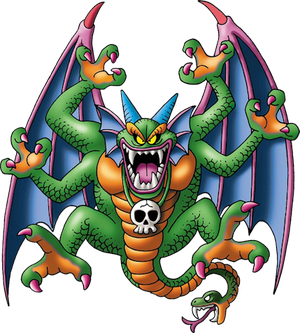
Malroth, known in Japan as Sidoh, is a character in the video game Dragon Quest II. He is its final boss, though he is rarely mentioned and never seen until he is fought at the end of the game. His boss battle was notable for its difficulty, particularly due to his use of the spell Fullheal, which recovered his health points in full. His design was created by Akira Toriyama. He also appears as a main character in the game Dragon Quest Builders 2 as a young man with no memories, assisting the protagonist in surviving and rebuilding a world, while grappling with strange voices and his inability to create things. His appearance in Dragon Quest Builders 2 earned positive reception, praised for enhancing the game and creating heartfelt moments in the game.

Puff-puff is an onomatopoeia that conveys a woman's breasts being rubbed in someone's face. It was first created by Akira Toriyama, creator of Dragon Ball and lead artist of Dragon Quest, having it featured in both. In Dragon Quest, it appears in multiple games as a service a character may receive. It has been featured in a non-sexual way in Dragon Quest as well through methods such as having two Slimes being used to simulate the act, or by swapping the performer for a man, which has been criticized for lacking consent by critics. It has been routinely censored in the Dragon Quest series in English until Dragon Quest XI. Multiple video games in other series include the puff-puff scene or make references to it, including 3D Dot Game Heroes, Yakuza: Like a Dragon, Final Fantasy XIV, and Dragon Ball Xenoverse.

Psaro is a character in the 1990 video game Dragon Quest IV. He is the primary antagonist of the story, leading a charge to wipe out humanity for the sake of demons, particularly due to his infatuation for an elf named Rose, who suffered under humans. He wishes to find and kill the human prophesized to one day defeat him, which causes him or his minions to come into contact with one or more of the multiple main heroes of the game who later come to support the prophesized hero in their quest. He comes to assume the form of Psaro the Manslayer after a tragedy pushes him to the brink. A sixth chapter was added to the PlayStation version that expands Psaro's story and features him as a playable character. He is also the protagonist of the 2023 game Dragon Quest Monsters: The Dark Prince. His design was created by Akira Toriyama. Psaro has been generally well received, praised as a tragic villain and for the multiple forms he goes through in the battle against him.

Alena is a character in the 1990 video game Dragon Quest IV, one of its main characters. She is the star of the second chapter, going out to explore the world and become a strong warrior with her retainers Kiryl and Borya, before discovering her kingdom wiped out. She later joins with the protagonist of the game in their quest to defeat the leader of the monsters, Psaro, and save the world. Her design was created by Akira Toriyama, and she is voiced in Japanese by Shoko Nakagawa. She is a fan favorite Dragon Quest IV character, noted as a strong female character by multiple critics, one from RPGFan noting how rare this was on the NES.

The Hero is the protagonist of Dragon Quest V. He starts out the story as a child, the son of Pankraz, who suffers through various tragedies before growing up, getting married, and having children. Unlike previous Dragon Quest protagonists, he is not a Legendary Hero, instead being a monster tamer, a mechanic added due to the popularity of Healie from Dragon Quest IV. He was created by Yuji Horii and designed by Akira Toriyama. He appears in other works, including the film Dragon Quest: Your Story. The Hero has received positive reception, with critics commenting on how impactful his tragic life was and how iconic a design he had.
Enix's role-playing video game Dragon Quest IV (DQIV), features eight permanent player characters in the Nintendo Entertainment System version, and nine in the PlayStation and Nintendo DS versions. The chapter structure of DQIV results in a new set of characters being controlled in each chapter; it is not until the fifth chapter that the Hero becomes the controllable protagonist.
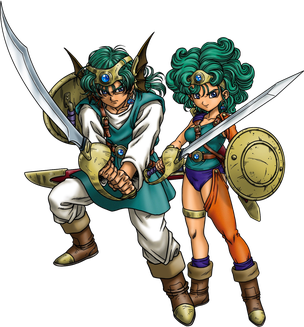
The Hero is the protagonist of Dragon Quest IV, and can be male or female. They do not have a default name, and can be given a name by the player. They are the second Hero in Dragon Quest to allow players to make them male or female, and the first to give the female Hero a distinct design. During the course of the story, the game's antagonist, Psaro, causes the death of their village, including their friend Eliza. They journey to defeat Psaro, joining other characters along the way.

Ladja is a character in the 1992 video game Dragon Quest V. He is one of the primary antagonists, responsible for the death of the Hero's father, Pankraz, and the subsequent enslavement of the Hero. He is the minion of the game's final villain, Grandmaster Nimzo. He was designed by Akira Toriyama and created by Yuji Horii, who aspired to create a villain who spanned multiple generations and who would ultimately be defeated in the end. He also appears in the film Dragon Quest: Your Story as an antagonist, which is based on the story of Dragon Quest V. He has received generally positive reception, with critics noting his superiority as the game's antagonist to his master, Nimzo, as well as noting how sadistically he treats the Hero and his father.
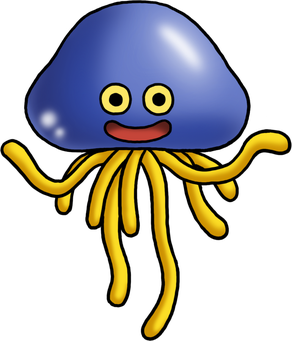
Healie, also known as Hoimin is a character in the 1990 video game Dragon Quest IV. He is a Healslime, a variant of the Slime monster from the series, who aspires to become a human, joining the warrior Ragnar McRyan in his quest to rescue kidnapped children from minions of Psaro. In promotional media for the franchise, he has been portrayed by Kanna Hashimoto.
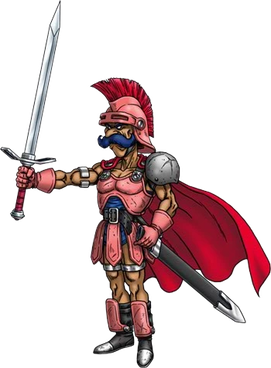
Ragnar McRyan, known in Japan as Ryan is a character in the 1990 video game Dragon Quest IV. He is one of multiple characters who assist the game's Hero in their battle against the monster Psaro. He stars in chapter 1, allying with the monster Healie to rescue children kidnapped by Psaro's minions. He was the first playable character in the NES version of the game. He has appeared in multiple other games, including the Itadaki Street and Dragon Quest Heroes series.

Maya and Meena are two characters in the 1990 video game Dragon Quest IV. Maya is a dancer and Meena a fortune teller. The two are sisters who set out on a journey to avenge their father's murder. They appear as the lead characters of the fourth chapter, and join the Hero in the fifth chapter to defeat the monster Psaro. They were created by Yuji Horii and designed by Akira Toriyama, and have been the subject of praise for both their designs and concepts, particularly Meena's use of tarot cards as weapons and Maya's beauty. The music played for the pair has also received praise, with critics identifying folk music and Middle Eastern music inspirations for their theme.

The Hero, also known as Loto in Japanese and Erdrick in English, is the protagonist of the 1988 video game Dragon Quest III. Unlike previous Dragon Quest protagonists, this Hero can be male or female, though fans criticized the lack of differences between the two gender options. They are the child of Ortega, who went missing after seeking out the villain Baramos. The Hero assumes this quest on their 16th birthday. The male Hero appears in Super Smash Bros. Ultimate as a playable character as part of a character called "Hero," alongside the heroes of Dragon Quest IV, Dragon Quest VIII, and Dragon Quest XI. They are a silent protagonist save for one line, which was not well-received by fans. The lack of differences between the male and female Hero received criticism as well, leading to efforts to improve this in Dragon Quest IV. The Hero has been identified as an iconic Hero, with multiple critics identifying their design as a foundational one, citing the protagonist of the light novel Maoyu as an example.


















